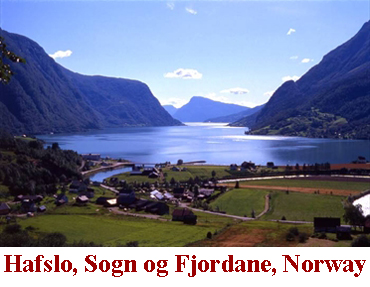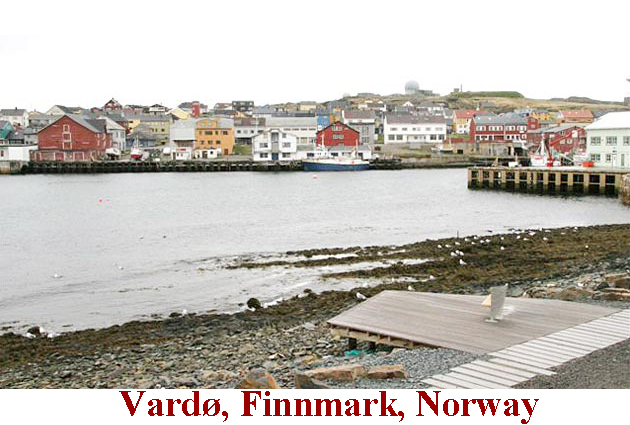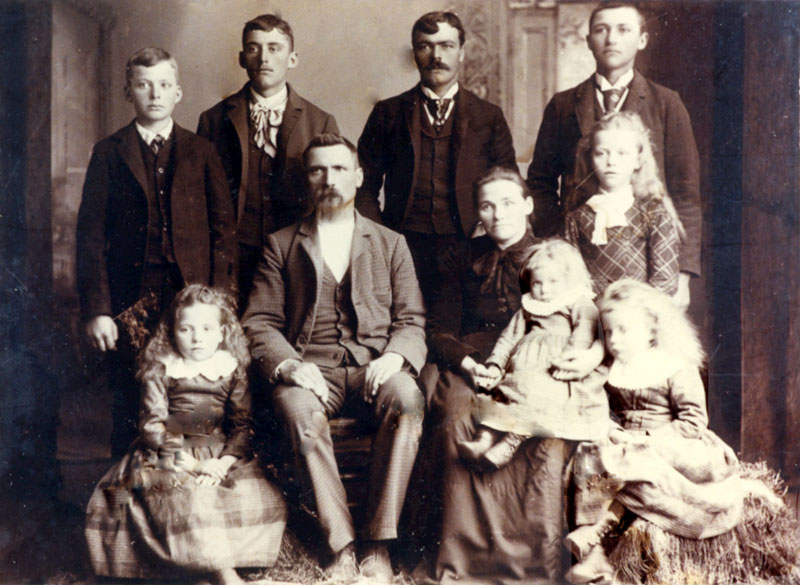The Norway / Michigan
/ South Dakota Nelsons
Hans and Gustava
Norstrøm Nelson
Hans Nelson
– Anton Nickolai Nelson - Lillian Mae Nelson Kipp
NORWAY
Hans Nelson (Nielson) was born on October
9, 1842 and baptized on October 16, 1842. Place of birth was Hafslo
Parish, Luster Kommune, Sogn og Fjordane, Norway.
Luster is located in a very beautiful area at the end of Sogn og Fjordane,
the largest fjord in the world, and near Jostedal Glacier, the largest
glacier on the continent of Europe.  Parents of Hans were Nils Nilsen
(1816-1849) and Lisabeth Nilsdotter (1806-1895). The family lived
on the Solvornstranden farm at the time of his birth. Hans had two brothers,
Niels and Anders, one sister, Nielsine, and two half brothers, Lars
and Hermund. Lars was the son of Nils and Hermund was the son
of Lisabeth.
Parents of Hans were Nils Nilsen
(1816-1849) and Lisabeth Nilsdotter (1806-1895). The family lived
on the Solvornstranden farm at the time of his birth. Hans had two brothers,
Niels and Anders, one sister, Nielsine, and two half brothers, Lars
and Hermund. Lars was the son of Nils and Hermund was the son
of Lisabeth.
Gustava Karoline Andersdatter Norstrøm
was born on December 20, 1846 in Alten Parish, Kafjord, Finnmark, Norway.
Alten is located on the northern coast of Norway, above the Arctic Circle.
Parents of Gustava were Anders Petterssen Norstrøm (1818 – 1876)
and Marie Josefsdatter (1820 - ?). Both of Gustava’s parents
were born in Sweden.
Records indicate that on December 31,
1862 Hans and his half brother, Hermund Pederson, moved from Solvorn
to Vesterålen. Vesterålen
is a very large island located off the western coast of Norway, above
the Arctic Circle, but south of Alten.  The reason for the move
is not known but it may have been related to military service as there
was a military facility there. Hans later served as a Musketeer in
the Norwegian Army in Vardø. Vardø is located near Alten. The next record of Hans is his marriage to Gustava
Karoline Norstrøm on October 18, 1868 in Vardø, Finnmark, Norway.
Two sons, Anton Nickolai (1868) and Carl Johan (1870), were born to
Hans and Gustava in Vardø.
The reason for the move
is not known but it may have been related to military service as there
was a military facility there. Hans later served as a Musketeer in
the Norwegian Army in Vardø. Vardø is located near Alten. The next record of Hans is his marriage to Gustava
Karoline Norstrøm on October 18, 1868 in Vardø, Finnmark, Norway.
Two sons, Anton Nickolai (1868) and Carl Johan (1870), were born to
Hans and Gustava in Vardø.
IMMIGRATION
Hans and his family may have departed
from Vardø to Trondheim in the spring of 1872 as the beginning
of their journey to America. The method of travel was likely aboard
a ship rather than overland.
Hans, Gustava, and family continued
their emigration to America with registration on March 17, 1872, and
departure on May 29, 1872 from Trondheim, Norway. Hans’ occupation
at the time was listed as Grubarb, (miner) and residence as Alten.
Their destination was noted as Hancock, Michigan located on the upper
Michigan Peninsula. The agent they booked passage with was Ennis
(Allan Brothers and Co.). The tickets were marked as “Bill bet.
IAmerika” which means that their passage was paid for from a source
in America, possibly a mining company in the Hancock, Michigan area.
The journey from Trondheim to England,
on the S/S Norway, made stops on the way in Christiansund, Aalesund,
and Bergen Norway, and Leith, Scotland before arriving in Newcastle,
England. The next portion of the trip was via train to Liverpool,
England. On arrival they boarded a transatlantic ship for Quebec.  The departure date from Liverpool, England was most likely June 6, 1872
on the S/S Hibernian of the Allen Line. The S/S Hibernian was a three
mast, single screw steamship. They arrived in Quebec, Canada on June 17, 1872.
The departure date from Liverpool, England was most likely June 6, 1872
on the S/S Hibernian of the Allen Line. The S/S Hibernian was a three
mast, single screw steamship. They arrived in Quebec, Canada on June 17, 1872.
The final portion of the trip was from Quebec, Canada to Hancock, Houghton County, Michigan. The question is what method of transportation did they use? A Norwegian immigrant wrote several articles for “Billed-Magazin” in 1869 that gave guidance to future immigrants. He suggests that immigrants could travel west by train from St. Levi, across the St. Lawrence River from Quebec, to Sarnia, Ontario. Since there was no railroad service to Hancock until about 1883, Hans and family may have traveled on a steamship from the Sarnia / Port Huron area to Houghton County. There were supply steamships which ran a regular route from Port Huron to Houghton County through Lake Huron, St. Mary’s Canal, and Lake Superior.
Some of Gustava’s siblings immigrated
to Houghton County, Michigan previously. Lisa Gretha immigrated
in 1871, Marie Helene in 1868, Peter Anton in 1869, and Johan Fredrik
in 1872. Nils Olaf immigrated later in 1877. Gustava’s sister, Henriethe,
and her mother Maria immigrated in 1878. The only family members who
did not immigrate to America were Gustava’s dad who died in December
1876 and her sister Emilia, who died in January 1877.
Hans, Gustava, Anton, and Johan may
not have been the first direct Nelson ancestors to immigrate to America.
Han’s grandmother, Anna Olsdotter, and his great aunt, Kari Nielsdatter,
may have immigrated in 1857. Anna at the time was a widow.
Records indicate that Anna, and Kari moved from Hillestad, Norway to
Hafslo, Norway on September 4, 1857 with their destination listed as
Amerika. I have found no record to determine if or when
they actually left Norway. One source states they lived in Spring
Prairie, Wisconsin and that Anna died there in 1877.
MICHIGAN
Hans and Gustava became the parents
of their third son, Edward in 1873 while they lived in Houghton County,
Michigan. It is believed that Hans worked in the mines there as
his occupation when he left Norway was a miner. While they lived
in Michigan Hans filed the initial papers for naturalization in Keweenaw
County, Michigan. He later applied for and received citizenship
on April 11, 1882 in Dakota Territory. Granting of citizenship
to Hans extended that same citizenship to Gustava, Anton, and Johan
as well.
DAKOTA TERRITORY
In the spring of 1876 Hans, Gustava,
and the three boys moved to Dakota Territory. The possibilities of land ownership provided by the Land Grant program may have been the reason for heading west. How did they get to Dakota Territory? The Houghton County area did not yet have railroad service in 1876 but water traffic on Lake Superior had developed. Ships traveled to Duluth, Minnesota on the western shore of the lake. Railroad service existed from Duluth to St Paul and beyond to Sioux City, Iowa. Rail service to the Big Sioux Valley are did not begin unit 1878 when service was extended to Sioux Falls, Dakota Territory and in 1879 to Pipestone, Minnesota. However roads had been completed in 1857 from St Paul to the Big Sioux River area. It was the first road in Minnesota with bridges and furnished good facilities for travel and early immigration. The road was a project of the War Department for use as a military road. Their journey to Dakota Territory may have been by steamship from Houghton County, Michigan to Duluth, Minnesota, then railroad to at least St Paul or further along the route toward Sioux City, Iowa. At some point they must have then traveled overland by stage or other means to their final destination.
Hans on June 1,
1876 made an application for settlement and cultivation of a 160 tract
of land under the Homestead Act with payment of a fee of $13.99.
The Homestead Act of 1862 allowed people to settle up to 160 acres of
public land if they lived on it for five years and grew crops or made
improvements. The land did not cost anything but did require a
registration fee.
The land was described as:
SWSE quarter of Section 30, Township
104-N, Range 49-W, Fifth PM,
NWNE quarter of Section 31, Township
104-N, Range 49-W, Fifth PM,
Lot 1 of SESW quarter of Section 30,
Township 104-N, Range 49-W, Fifth PM, and
Lot 1 of NENW quarter of Section 31,
Township 104-N, Range 49-W, Fifth PM
It is located near Baltic, South Dakota.
Final approval was granted at the Land Office in Mitchell, Dakota Territory
on February 15, 1883. A final fee of $4.00 was paid at that time.
Transfer of title occurred on March 20, 1884.
Before final approval Hans needed to
certify he was a citizen of the United States, and was living on the
property and improving such property. Statements by Hans and two
others state that he resided on the property since October 25, 1876
and cultivated 40 acres for six seasons.  The residence was described
as a dwelling of 12 feet by 19 feet, one story high, two rooms, three
windows, and two doors. The house was occupied by Hans, Gustava,
and their six sons. In Homestead documents he states that he built
a house, a stable, and dug a well. While it is not stated in the
Homestead Papers, the residence was a sod house. Total value was stated
at $200.
The residence was described
as a dwelling of 12 feet by 19 feet, one story high, two rooms, three
windows, and two doors. The house was occupied by Hans, Gustava,
and their six sons. In Homestead documents he states that he built
a house, a stable, and dug a well. While it is not stated in the
Homestead Papers, the residence was a sod house. Total value was stated
at $200.
Three sons and three daughters were
born to Hans and Gustava in Dakota Territory. They were Waldemar
(1876), Theodore (1878), William (1880), Hannah Elise (1883), Emma Constance
(1885), and Laura Marie (1888). A fourth daughter, Mina Charlotte (1890)
was born in South Dakota after it obtained statehood.
CENSUS
1865 CENSUS
The 1865-telling (census) for Talvigs,
Finnmark, Norway lists Gustava Norstrøm, age 20, single, and
working as a Tjenestepige (female servant) at the household of Paul-I
Hofseth.
1880 CENSUS
The 1880 Census for Township 104, Dakota
Territory lists Hans as age 38, and Gustava as age 33. Children
listed are Anthon, age 13, Carl J., age 9, Edward, age 6, Waldemar,
age 3, and Theodore, age 1. Hans is noted as a farmer, Gustava
as keeping house, and Anthon as working on a farm. William who
was born late in 1880 and died in 1885 does not appear in any census.
1890 Census
Most of the 1890 Census was destroyed.
1900 CENSUS
The 1900 Census for Dell Rapids Township,
Minnehaha County, South Dakota lists Hans as age 56, and Gustava as
age 53. Others listed are Charles (Carl), age 30, Sarah (Sigrid),
age 25 daughter-in-law, Henry, age 6 grandson, and Clara, age 1 grand-daughter.
Hans and Carl’s occupation is listed as farmer. All adults are
noted as being able to read, write, and speak English.
1910 CENSUS
The 1910 Census for Dell Rapids City,
Minnehaha County, South Dakota lists Hans as age 67 and Gustava as age
62. Others listed in the household include their daughter Laura
Sather, age 22, and grandson Lloyd, age 2. Laura’s husband Louis
had died in 1907 at the age of 24 just months prior to the birth of
Lloyd.
1920 CENSUS
The 1920 Census for Dell Rapids Township,
Minnehaha County, South Dakota lists Gustava age 72. Hans was
not listed as he died in 1911. Gustava is shown is living in the
household of Waldemar, Nelson. The 1920 Census was the last for
Gustava as she died in 1923.
COPYRIGHT 2009 BY E. MICHAEL KIPP
July 6, 2009
SOURCES
Digitalarkivet, Emigranter fra Trondheim
1867-1930 (Emigration of Hans Nelson and Norstrøm families)
Digitalarkivet, Døypte I Hafslo 1717-1894
(eigar Luster commune) (Hans Nelson birth)
Digitalarkivet, Flytting I delar av
Sogn og Fjordane I perioden 1816-1926 (Relocation of Hans Nelson)
Parish Record, Births 1842 (Hans Nelson)
Parish Record, Marriage 1868 (Hans
Nelson and Gustava Norstrøm)
A Century of Norwegian Emigrant Routes
by Yngve Nedrebø
Concerning Emigration by John A. Johnson translated by C. A. Clausen (Volume 33, Page 205)
(Billed-Magazin, January 23, 30, February 6, 13, March 13, 20, 1869. Johnson, who became a prominent industrialist, signed these articles with his original name, J. A. Johnsen Skibsnæs. See Agnes M. Larson, John A. Johnson: An Uncommon American, Northfield, Minnesota, 1969).
Norway Heritage web site – S/S Norway,
Allan Line 1872, http://www.norwayheritage.com/p_ship.asp?sh=norwa
Bureau of Land Management – General
Land Records
US Federal Census of 1880, Township
104, South Dakota
US Federal Census of 1900, Dell Rapids
Township, Minnehaha County, South Dakota
US Federal Census of 1910, Dell Rapids
City, Minnehaha County, South Dakota
US Federal Census of 1920, Dell Rapids
Township, Minnehaha County, South Dakota
1865 Telling – Talvigs, Finnmark,
Norway

